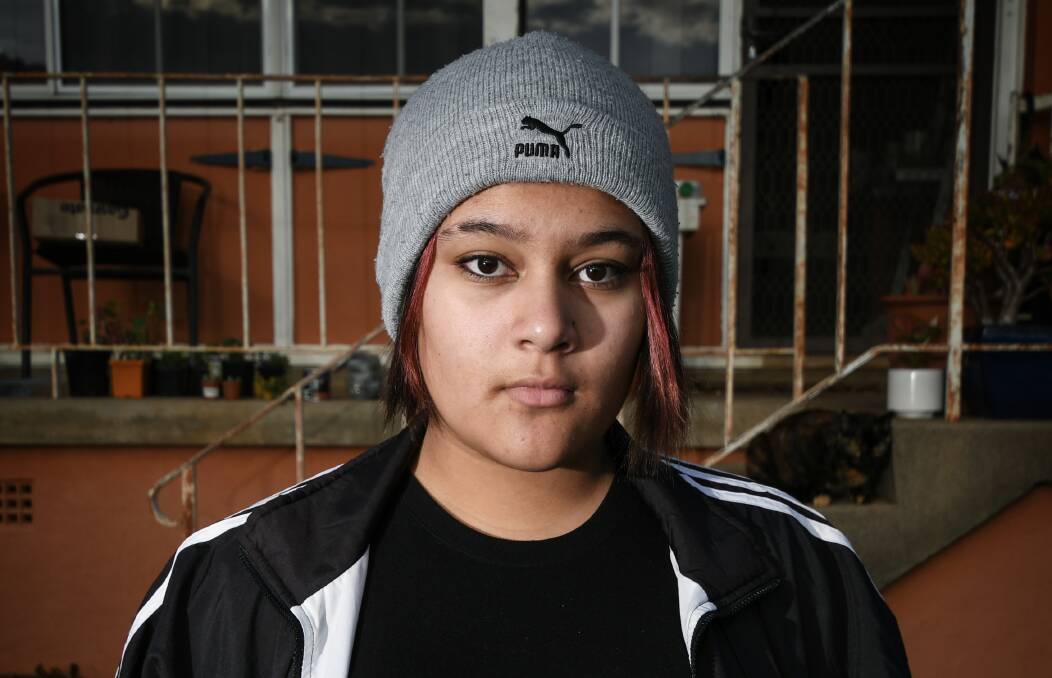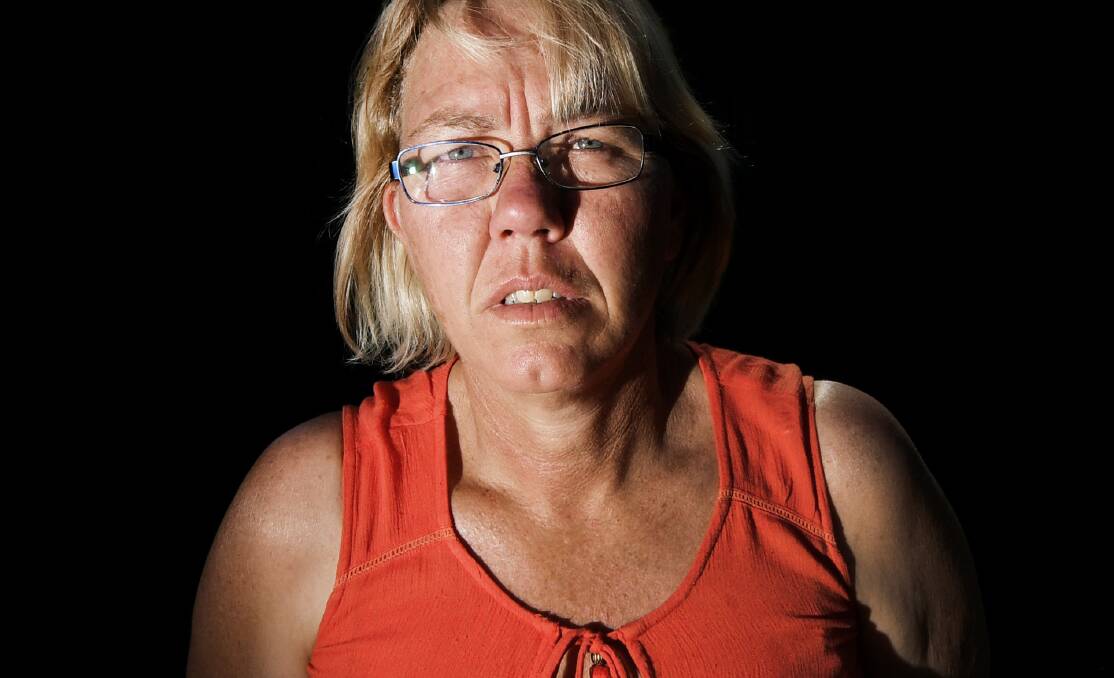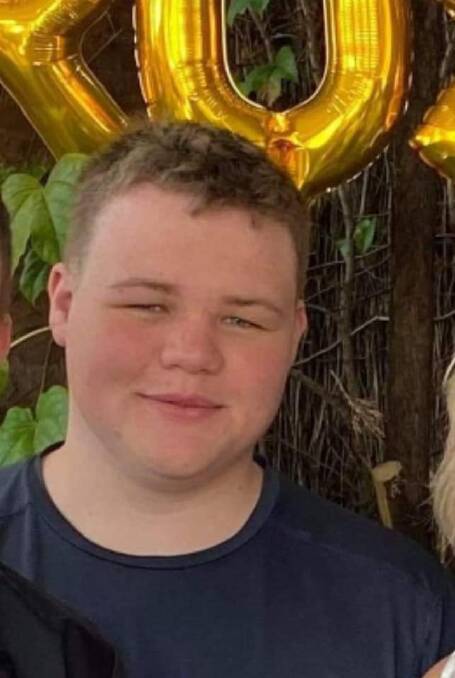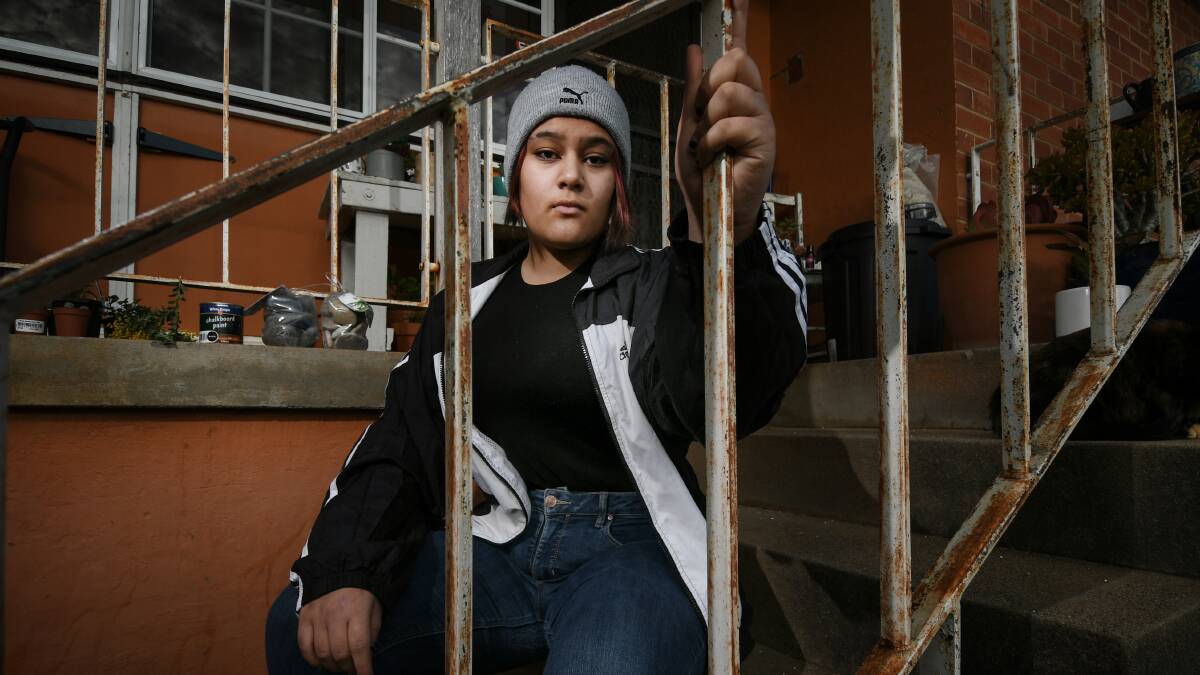
Trigger warning: this story contains stories of suicide and attempted suicide. If you need help contact Lifeline on 13 11 14.
Subscribe now for unlimited access.
or signup to continue reading
It took just moments for two strangers to strap a 16-year-old girl down in the back of a van.
Three days earlier she tried to end her own life.
Rae Walsh was set for a four-hour journey to a totally new place, where she would be forced to live among strangers hundreds of kilometres from friends and family.
The van door slammed shut, just 100 metres from Tamworth's 25-bed mental health unit, Banksia.
It has almost no capacity to treat children, so Rae's only option was Newcastle's Nexus unit.
Tears rolled down her mother Yolanda Coppola face as she watched the vehicle go.
"It's like trusting your most precious, precious possession to a stranger," she said.
"You just feel so powerless. You don't have any choices really, you have to trust what they're saying is the right thing."
This is the reality for children with mental health issues in rural NSW as recently as April. With no plans for change in the next decade, Yolanda won't be the last mother to see her child taken away even after NSW Health finishes its $40 million new Banksia mental health unit
State government modelling shows the unit caters to 171,619 people across a region the size of Tasmania, and that there is demand for up to three child and adolescent beds. Not one will be added to the new 33-bed unit.
Advocates believe the decision will have knock-on effects to local service standards in a city that has just one child and adolescent psychiatrist on shift for a day every fortnight.
A specialist unit would mean more dedicated staff in a city where people struggle to get into the system, even in a crisis. Instead, a tacit policy of health centralisation will continue.
'Swimming upstream': Will's story
Between 2014 to 2018, 42 local residents died by suicide, according to the Australian Institute of Health and Welfare.
The next statistics will include Jane Hunt's son, William Rawsthorne.
The single mother was away in Lightning Ridge on October 14, 2020 when her son called Triple Zero to tell police he would end his life.
He didn't want to be found by his mum. But she saw him die anyway, watching on her phone through the security camera footage, as the passenger in a car racing to take her to his side.
His last words to her were in a text message: "I love you mum, I am so sorry, I love you."

Will was a smart and funny kid with big dreams and big problems. He struggled in social situations, lived with trauma, and desperately needed structure. A 2019 psychologist's assessment concluded he was an "extremely at-risk young person" who was "at risk of homelessness, self-harm and, or suicide". The red flag was raised.
The first signs of William's mental illness emerged at seven years old. Ms Hunt spent another seven "swimming upstream" against a current of bureaucracy that did less than nothing to help her.
It's an experience a dozen parents have described to the Leader in interviews for this story.
"We're left high and dry. I've cried myself to sleep many a night trying to think outside the box and try something. And it's a very, very lonely road," she said.
Her relationship with Will was poisoned by her efforts to preserve his life. She still cries while talking about it.
"You did feel like a warden and a governor sometimes. I'm sure he felt that it was like that, because I know I did," she said.
"As a parent you know, whilst this stuff is going on and you're making these choices, you very much want that little boy back that you had. I just wanted to be his mum, but instead I was his warden, his governor, his psychiatrist, his counsellor, his teacher."
She believes Will fell through the cracks because of his age. He was almost always too young. She did find support at a multisystemic therapy service, but that help was cut off after 40 weeks. Will's health went into a spiral.

At age 16, he suddenly became both too old and too young at the same time.
Ms Hunt said she was told by the NSW Department of Family and Community Services (FACS) it would no longer fund the care he needed. When he died, his only service provider was a single psychologist, once a month.
She believes Tamworth simply didn't have the resources required to diagnose and treat her son until he was 18.
He never made it. He was one month and 23 days away from his 18th birthday when he died.
An autopsy for the coroner was carried out in Newcastle and, in a final kick in the guts, Ms Hunt will be billed for the cost of paperwork to get his last letters and effects - and even had to pay for his body to be sent back to Tamworth.
Will never saw the inside of Banksia or Nexus. His mum said he was repeatedly denied access because he was considered low-risk, despite years of violent outbursts at school. In May, Gunnedah man Michael Peachey died at the hands of police during a mental health incident after "begging" for help from the same services - and being denied.
- Contact Lifeline on 13 11 14 or Kids Helpline on 1800 55 1800.
'More services just as a baseline'
NSW Government data shows the Hunter New England Health region has among the highest hospitalisation rates for intentional self-harm in the state - some 145 per 100,000 people per year. The rate is far higher for women aged 15 to 24 at 525 hospitalisations per 100,000 people. In major cities, it's nearly half that.
The local health authority's own modelling shows that even after Banksia is upgraded there will be a shortfall of up to 34 mental health beds for the region.
But bean counting has trumped demand. The Leader has exclusively revealed that demand was not the reason behind the decision to forgo beds for children and teenagers at Banksia. Instead, Hunter New England Local Health District planners determined "economies of scale" could not be achieved in a small unit.
University of New England (UNE) Professor Myfanwy Maple is a former member of the prime minister's expert advisory committee on suicide prevention and served six years as an Official Visitor of mental health institutions under the NSW Mental Health Act, including Banksia and Armidale's Clark Centre.
"I think we need to be providing adequate support for regional Australians, just as a baseline. I think that absolutely Banksia needs a massive upgrade; it has needed that for many, many years. It certainly cannot keep up with the demand that has been there," Professor Maple said.
Suicide and self-harm rates in rural NSW have been consistently higher than in metropolitan areas, Professor Maple said, partly due to distance and the lack of dedicated mental health services.
There is a gap between low-intensity care provided by Commonwealth-funded organisations like Headspace and high-level care in mental health units like Nexus and Banksia, she said.
There's a gap for older adolescents, patients transported out of town and back, and for many people with drug and alcohol problems. Bridging these gaps often comes down to the advocacy and financial wherewithal of parents. It's one of the reasons behind why Will's story is all too common, Professor Maple said.
"If you're wealthy and you have private health care, you will probably get better mental health care in that situation for that young man," she said.
Tamworth's one-day-a-fortnight visit by a child and adolescent psychiatrist is not enough. Additional local high-care options could help, Professor Maple said.
"We've done lots of studies with carers who say, 'I don't know how to do suicide watch. I don't know how to advocate to all these systems," she said.
"It puts a parent in an impossible situation. Also for that psychologist, it's an impossible situation. They've got heavy caseloads. They're only able to spend x number of sessions with a person," she said.
"That's amplified if that person is under 18. That gap between 16 and 18 - where you're often not seen as a priority in child and adolescent mental health services anymore, but you're also not eligible, often, for adult mental health services - that will continue to be a massive problem."
People in need are locked in constant battle with centralised care models and the complexities of a health system funded by both the state and Commonwealth.
Psychiatry is one of the most centralised medical specialties of all. Almost nine out of 10 psychiatrists live in the major cities, according to a report by the Australian Institute of Health and Welfare. Psychiatrists in remote areas work on average nearly eight hours per week more than their city counterparts.
Professor Maple said centralisation moves resources away from the people most at-risk, like Aboriginal and Torres Strait Islanders, and paradoxically forces the poorest to spend the most getting access to highest-level care - or miss out.
An acute care unit like Banksia doesn't typically provide primary-level care, but a child and adolescent unit can act like a doctor magnet, drawing in wraparound services like psychologists and specialist psychiatrists, she said.
Catholic health service provider Centacare's executive manager Josie Hoffman said psychologists are overworked dealing with the "huge demand" in the region, and Covid-19 has driven up referrals even more
"It's a constant battle," the Tamworth psychologist said.
"Headspace has expanded significantly over the last seven years; it's huge now. Our Headspace programs cover the region. Yet we're still having to manage waitlists. That's telling you that the needs out there are greater than what our community services can meet."
Enhancing acute facilities like Banksia would help primary services like Headspace reach everyone.
"From an allied health perspective we would prefer to have those services here," she said.
It would also act as a statement from government that the mental health of children and teenagers in Tamworth matters.
A spokesperson for Hunter New England Health said that the new Banksia unit "will continue to provide services for children and adolescents and vulnerable persons, as it currently does".
It will not include any full-time child and adolescent beds, but it will include two "pods" which can serve as beds for young people, for a 72-hour period.
The spokesperson said the pods will help provide space and time for assessment and referral to other child and adolescents specialty services for longer-term treatment.
"This aligns with best practice care for young people accessing mental health services being managed closer to families and supports where possible," he said.
"In addition, the entire unit is being designed to have flexibility, to cater for different levels of acuity, ages and care."
In line with contemporary national and international models of care the local health district plans to "transition consumers from hospital to community-based care when appropriate", he said, improving access to adult acute beds.
The unit upgrade will add eight new beds, all of them specialist beds for seniors.

Take care. Fragile.
When Rae grows up she wants to run her own restaurant.
In April, she attempted suicide. She was stressed and overworked and needed help.
Her first port of call was a "hopeless" Tamworth Hospital. She was embarrassed to be wheeled into the facility, strapped to a bed, while people watched on.
A few days later, with her physical symptoms treated, it was time for her mental health to get a turn.
Rae remembers the four-hour journey to Newcastle was boring. She couldn't really move due to the straps and she couldn't sleep either. She felt like freight.
"I was just really sad, because they were like 'no, mum can't go with you, you have to do this by yourself'. I was just sitting in the vehicle and mum was just crying at the window. I was like, 'where are we going? Oh Newcastle. Okay, do I have any say in this? No? Okay,'" she said.
"I kind of just felt like I was being punished for what I did.
"They sent me away, I didn't have any of my things, I came with the clothes on my back and nothing else until mum came up and brought my clothes three days later."
The Nexus unit was almost full on the Easter long weekend. She remembers it packed with children. Most were kind and friendly; one spent the week screaming and another asked her if she could get access to a gun. Most of them were not from Newcastle.
Rae felt isolated, scared, frustrated. After a week she was released onto the street. She and her mum made their own way home.
Now, Rae is in the same mental health carousel as so many others, trying to get better hundreds of kilometres from the unit that treated her in the first place.
"I've been referred to and from people. I've finally got this appointment with a psychiatrist in town, but I've had two bookings cancelled," she said.
Five months after a suicide attempt, she doesn't have a regular doctor and doesn't feel like she's making progress. She described the sector as a "rollercoaster".
"I am just so tired," she said.
"I'm just honestly ready to give up on just trying to get help. Because I've been trying since I got back and nothing's helping, nothing is happening. I'm just telling my story again and again.
"They're putting labels on me and I'm like tell me something I don't know, tell me how I can improve, tell me how I can fix it, instead of labelling me and pushing me into a corner."
The Leader asked Rae and her mum what they would say to the person who made a decision not to build a children's unit in Tamworth.
"I would ask them [to] imagine your child leaving and you don't know how you're going to get there, you've got no means to get there," Yolanda said.
Rae's was much simpler: "F*** you".
- If you or someone you know is in crisis and needs help, contact Lifeline on 13 11 14 or Kids Helpline on 1800 55 1800.



